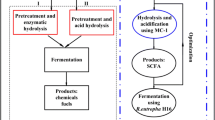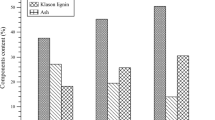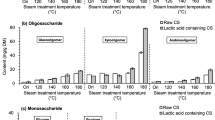Abstract
The difference in the enzymatic hydrolysis yield of acid-catalyzed steam-exploded corn stover (ASC) before and after washing with water reached approximately 15 % under the same conditions. The reasons for the difference in the yield between ASC and washed ASC (wASC) were determined through the analysis of the composition of ASC prehydrolyzate and sugar concentration of enzymatic hydrolyzate. Salts produced by neutralization (CaSO4, Na2SO4, K2SO4, and (NH4)2SO4), sugars (polysaccharides, oligosaccharides, and monosaccharides), sugar-degradation products (weak acids and furans), and lignin-degradation products (ethyl acetate extracts and nine main lignin-degradation products) were back-added to wASC. Results showed that these products, except furans, exerted negative effect on enzymatic hydrolysis. According to the characteristics of acid-catalyzed steam explosion pretreatment, the five sugar-degradation products’ mixture and salts [Na2SO4, (NH4)2SO4] showed minimal negative inhibition effect on enzymatic hydrolysis. By contrast, furans demonstrated a promotion effect. Moreover, soluble sugars, such as 13 g/L xylose (decreased by 6.38 %), 5 g/L cellobiose (5.36 %), 10 g/L glucose (3.67 %), as well as lignin-degradation products, and ethyl acetate extracts (4.87 %), exhibited evident inhibition effect on enzymatic hydrolysis. Therefore, removal of soluble sugars and lignin-degradation products could effectively promote the enzymatic hydrolysis performance.





Similar content being viewed by others
References
Serrano-Ruiz JC, Ramos-Fernández EV, Sepúlveda-Escribano A (2012) From biodiesel and bioethanol to liquid hydrocarbon fuels: new hydrotreating and advanced microbial technologies. Energ Environ Sci 5(2):5638–5652
Morone A, Pandey RA (2014) Lignocellulosic biobutanol production: gridlocks and potential remedies. Renew Sust Energ Rev 37:21–35
Pereira SC, Maehara L, Machado CMM, Farinas CS (2015) 2G ethanol from the whole sugarcane lignocellulosic biomass. Biotechnol Biofuels 8:44
Banerjee D, Mukherjee S, Pal S, Khowala S (2016) Enhanced saccharification efficiency of lignocellulosic biomass of mustard stalk and straw by salt pretreatment. Ind Crop Prod 80:42–49
Huang H, Guo X, Li D, Liu M, Wu J, Ren H (2011) Identification of crucial yeast inhibitors in bio-ethanol and improvement of fermentation at high pH and high total solids. Bioresour Technol 102:7486–7493
Liu Y, Zhou H, Wang L, Wang S, Fan L (2016) Improving Saccharomyces cerevisiae growth against lignocellulose-derived inhibitors as well as maximizing ethanol production by a combination proposal of γ-irradiation pretreatment with in situ detoxification. Chem Eng J 287:302–312
Kim Y, Ximenes E, Mosier NS, Ladisch MR (2011) Soluble inhibitors/deactivators of cellulase enzymes from lignocellulosic biomass. Enzyme Microb Technol 48:408–415
Zhu J, Yang J, Zhu Y, Zhang L, Yong Q, Xu Y, Li X, Yu S (2014) Cause analysis of the effects of acid-catalyzed steam-exploded corn stover prehydrolyzate on ethanol fermentation by Pichia stipitis CBS 5776. Bioprocess Biosyst Eng 37(11):2215–2222
Jönsson LJ, Alriksson B, Nilvebrant NO (2013) Bioconversion of lignocellulose: inhibitors and detoxification. Biotechnol Biofuels 6:16
Palmqvist E, Hahn-Hägerdal B (2000) Fermentation of lignocellulosic hydrolysates. I: inhibition and detoxification. Bioresour Technol 74:17–24
Jing X, Zhang X, Bao J (2009) Inhibition performance of lignocellulose degradation products on industrial cellulase enzymes during cellulose hydrolysis. Appl Biochem Biotechnol 159:696–707
Oliva-Taravilla A, Tomás-Pejó E, Demuez M, González-Fernández C, Ballesteros M (2016) Phenols and lignin: key players in reducing enzymatic hydrolysis yields of steam-pretreated biomass in presence of laccase. J Biotechnol 218:94–101
Zhang N, Lai C, Li X, Zhu J, Zhang G, Yu S, Yong Q (2012) Effects of washing method on detoxification of steam explosion corn stalk. Chem Ind Forest Prod 32(6):32–36
Rajan K, Carrier DJ (2014) Effect of dilute acid pretreatment conditions and washing on the production of inhibitors and on recovery of sugars during wheat straw enzymatic hydrolysis. Biomass Bioenerg 62:222–227
Andrić P, Meyer AS, Jensen PA, Dam-Johansen K (2010) Reactor design for minimizing product inhibition during enzymatic lignocellulose hydrolysis: I. significance and mechanism of cellobiose and glucose inhibition on cellulolytic enzymes. Biotechnol Adv 28(3):308–324
Zhang H, Zhao J, Lin Z, Huang H (2011) Effects of neutralizing agents on enzymatic hydrolysis of corn stover pretreated by dilute acid-mediated steam explosion. Chin J Bioprocess Eng 9(1):1–4
Zhu J, Zhu Y, Jiang F, Xu Y, Ouyang J, Yu S (2013) An integrated process to produce ethanol, vanillin, and xylooligosaccharides from Camellia oleifera shell. Carbohydr Res 382:52–57
Jiang Z, Zhu J, Li X, Lian Z, Yu S, Yong Q (2011) Determination of main degradation products of lignin using reversed-phase high performance liquid chromatography. Chin J Chromatogr 29(1):59–62
Sluiter A, Hames B, Ruiz R, Scarlata C, Sluiter J, Templeton D, Crocker D (2008) Determination of structural carbohydrates and lignin in biomass. Laboratory Analytical Procedure (LAP) Issue Date: 4/25/2008 [S]. United States: National Renewable Energy Laboratory Golden
Ghose TK (1987) Measurement of cellulase activities. Pure Appl Chem 59:257–268
Kaya M, Ito J, Kotaka A, Matsumura K, Bando H, Sahara H, Ogino C, Shibasaki S, Kuroda K, Ueda M, Kondo A, Hata Y (2008) Isoflavone aglycones production from isoflavone glycosides by display of β-glucosidase from Aspergillus oryzae on yeast cell surface. Appl Microbiol Biotechnol 79:51–60
Yang J, Zhang X, Yong Q, Yu S (2011) Three-stage enzymatic hydrolysis of steam-exploded corn stover at high substrate concentration. Bioresour Technol 102:4905–4908
Sun Y, Cheng J (2002) Hydrolysis of lignocellulosic materials for ethanol production: a review. Bioresour Technol 83(1):1–11
Gruuno M, Väljamäe P, Pettersson G, Johansson G (2004) Inhibition of the Trichoderma reesei cellulases by cellobiose is strongly dependent on the nature of the substrate. Biotechnol Bioeng 86:503–511
Acknowledgments
The authors acknowledge the financial support from the National Natural Science Foundation of China (Grant No. 31100432), Key Research and Development Program of Jiangsu (BE2015758), National Science and Technology Pillar Program during the Twelfth Five-Year Plan Period (No. 2015BAD15B09), and a Project Funded by the Priority Academic Program Development of Jiangsu Higher Education Institutions (PAPD).
Author information
Authors and Affiliations
Corresponding author
Rights and permissions
About this article
Cite this article
Zhu, J., Shi, L., Zhang, L. et al. Difference analysis of the enzymatic hydrolysis performance of acid-catalyzed steam-exploded corn stover before and after washing with water. Bioprocess Biosyst Eng 39, 1619–1626 (2016). https://doi.org/10.1007/s00449-016-1637-2
Received:
Accepted:
Published:
Issue Date:
DOI: https://doi.org/10.1007/s00449-016-1637-2




